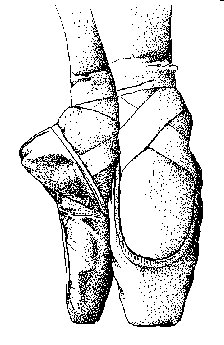 Attitude ah-teh-TEWD
Pose. To pose, balanced on one leg while the other leg is slightly bent at the knee, extended to either the front, side or back.
Battement bat-MAHN
Beat. The working leg is raised from the hip into the air and back to the starting position. The working leg passes through tendu and stays externally rotated. The purpose of this exercise is to loosen the hip joints and to turn out the legs from the hips
Coupé koo-PAY
Cut. This action is when one foot cuts away the other taking its place, but can be shortened to describe a single position. The working foot is either placed with the heel in front or behind the ankle of the standing leg.
Développé dayv-law-PAY
Develop. The working leg is drawn up the standing leg to passé. The leg then extends out externally rotated and held with control. The hips are level, and the foot lowers to a tendu and closes to the starting position to finish.
Passé pa-SAY
Pass. Generally this is a position passing through to the next, but can be shortened to describe a single position. The working foot is placed either in front or behind the knee of the standing leg.
Plié plee-AY
Bend. A bend of the knee or knees.
Demi-plié demi plee-AY
Half-bend. The heels stay flat on the floor. All jumps begin and end with a plié.
Grand plié grand plee-AY
Full Bend. The knees bend fully, so that the thighs are horizontal to the floor. When the knees are at least halfway bent, the dancer’s heels rise from the floor. As the dancer rises and the knees straighten, the heels go back down. The rise should take as long as the bend.
Relevé rel-eh-VAY
Rise. A rise of the body onto the ball of the foot or feet.
Tendu than-DOO
Stretch. Often done as an exercise at the barre from first or fifth position, the working leg is extended to either the front, side or back, gradually along the floor until only the tip of the toe remains touching the floor.
]]>
Attitude ah-teh-TEWD
Pose. To pose, balanced on one leg while the other leg is slightly bent at the knee, extended to either the front, side or back.
Battement bat-MAHN
Beat. The working leg is raised from the hip into the air and back to the starting position. The working leg passes through tendu and stays externally rotated. The purpose of this exercise is to loosen the hip joints and to turn out the legs from the hips
Coupé koo-PAY
Cut. This action is when one foot cuts away the other taking its place, but can be shortened to describe a single position. The working foot is either placed with the heel in front or behind the ankle of the standing leg.
Développé dayv-law-PAY
Develop. The working leg is drawn up the standing leg to passé. The leg then extends out externally rotated and held with control. The hips are level, and the foot lowers to a tendu and closes to the starting position to finish.
Passé pa-SAY
Pass. Generally this is a position passing through to the next, but can be shortened to describe a single position. The working foot is placed either in front or behind the knee of the standing leg.
Plié plee-AY
Bend. A bend of the knee or knees.
Demi-plié demi plee-AY
Half-bend. The heels stay flat on the floor. All jumps begin and end with a plié.
Grand plié grand plee-AY
Full Bend. The knees bend fully, so that the thighs are horizontal to the floor. When the knees are at least halfway bent, the dancer’s heels rise from the floor. As the dancer rises and the knees straighten, the heels go back down. The rise should take as long as the bend.
Relevé rel-eh-VAY
Rise. A rise of the body onto the ball of the foot or feet.
Tendu than-DOO
Stretch. Often done as an exercise at the barre from first or fifth position, the working leg is extended to either the front, side or back, gradually along the floor until only the tip of the toe remains touching the floor.
]]>

